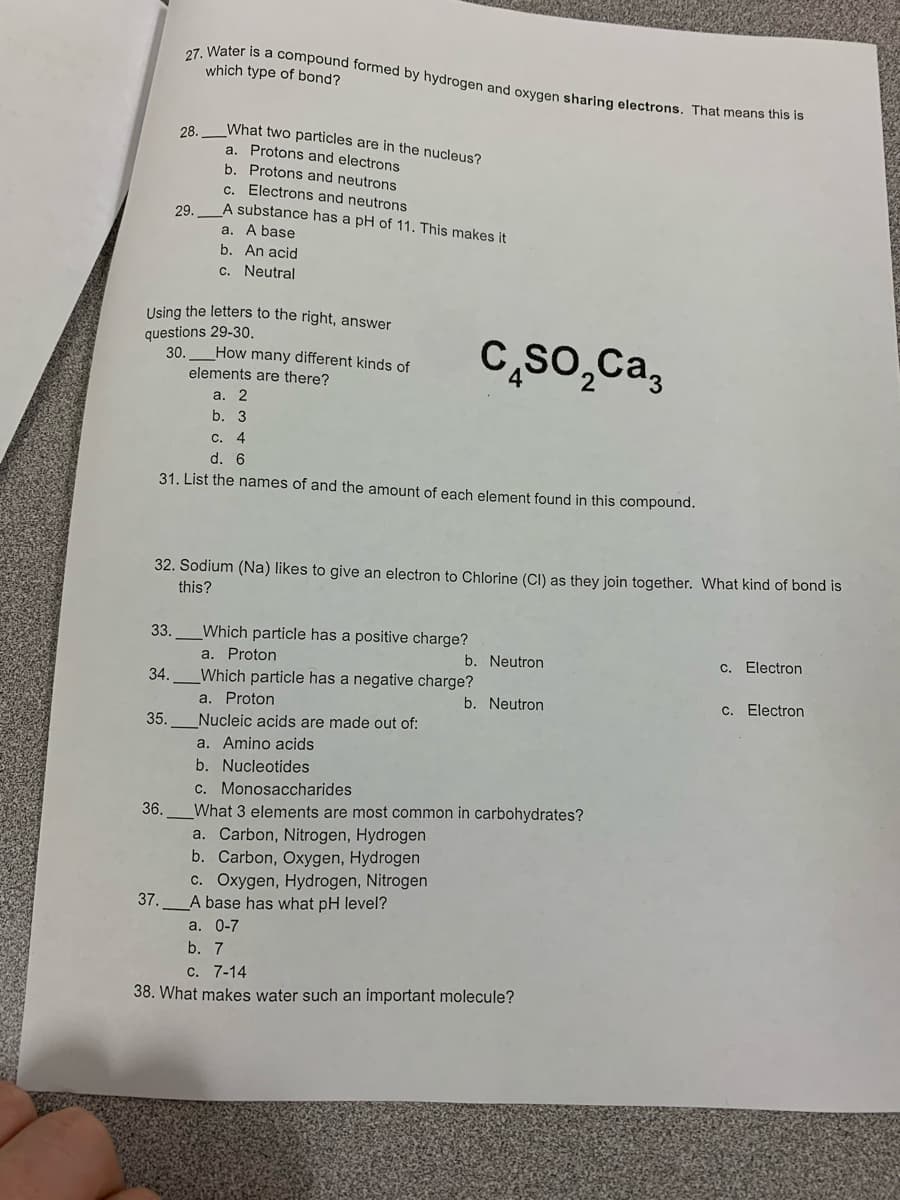27. Water is a compound formed by hydrogen and oxygen sharing electrons. That means this is which type of bond? What two particles are in the nucleus? a. Protons and electrons b. Protons and neutrons c. Electrons and neutrons A substance has a pH of 11. This makes it 28. 29. a. A base b. An acid c. Neutral
27. Water is a compound formed by hydrogen and oxygen sharing electrons. That means this is which type of bond? What two particles are in the nucleus? a. Protons and electrons b. Protons and neutrons c. Electrons and neutrons A substance has a pH of 11. This makes it 28. 29. a. A base b. An acid c. Neutral
Chemistry by OpenStax (2015-05-04)
1st Edition
ISBN:9781938168390
Author:Klaus Theopold, Richard H Langley, Paul Flowers, William R. Robinson, Mark Blaser
Publisher:Klaus Theopold, Richard H Langley, Paul Flowers, William R. Robinson, Mark Blaser
Chapter2: Atoms, Molecules, And Ions
Section: Chapter Questions
Problem 25E: The average atomic masses of some elements may vary, depending upon the sources of their ores....
Related questions
Question
100%

Transcribed Image Text:27. Water is a compound formed by hydrogen and oxygen sharing electrons. That means this is
which type of bond?
What two particles are in the nucleus?
28.
a. Protons and electrons
b. Protons and neutrons
c. Electrons and neutrons
A substance has a pH of 11. This makes it
29.
a. A base
b. An acid
c. Neutral
Using the letters to the right, answer
questions 29-30.
C,so,Ca,
30.
How many different kinds of
elements are there?
a. 2
b. 3
С. 4
d. 6
31. List the names of and the amount of each element found in this compound.
32. Sodium (Na) likes to give an electron to Chlorine (CI) as they join together. What kind of bond is
this?
33.
Which particle has a positive charge?
a. Proton
b. Neutron
С.
Electron
Which particle has a negative charge?
a. Proton
Nucleic acids are made out of:
34.
b. Neutron
c. Electron
35.
a. Amino acids
b. Nucleotides
c. Monosaccharides
What 3 elements are most common in carbohydrates?
a. Carbon, Nitrogen, Hydrogen
b. Carbon, Oxygen, Hydrogen
c. Oxygen, Hydrogen, Nitrogen
37.
36.
A base has what pH level?
a. 0-7
b. 7
С. 7-14
38. What makes water such an important molecule?
Expert Solution
This question has been solved!
Explore an expertly crafted, step-by-step solution for a thorough understanding of key concepts.
Step by step
Solved in 2 steps

Knowledge Booster
Learn more about
Need a deep-dive on the concept behind this application? Look no further. Learn more about this topic, chemistry and related others by exploring similar questions and additional content below.Recommended textbooks for you

Chemistry by OpenStax (2015-05-04)
Chemistry
ISBN:
9781938168390
Author:
Klaus Theopold, Richard H Langley, Paul Flowers, William R. Robinson, Mark Blaser
Publisher:
OpenStax


Chemistry: An Atoms First Approach
Chemistry
ISBN:
9781305079243
Author:
Steven S. Zumdahl, Susan A. Zumdahl
Publisher:
Cengage Learning

Chemistry by OpenStax (2015-05-04)
Chemistry
ISBN:
9781938168390
Author:
Klaus Theopold, Richard H Langley, Paul Flowers, William R. Robinson, Mark Blaser
Publisher:
OpenStax


Chemistry: An Atoms First Approach
Chemistry
ISBN:
9781305079243
Author:
Steven S. Zumdahl, Susan A. Zumdahl
Publisher:
Cengage Learning

Introductory Chemistry: A Foundation
Chemistry
ISBN:
9781337399425
Author:
Steven S. Zumdahl, Donald J. DeCoste
Publisher:
Cengage Learning


Chemistry
Chemistry
ISBN:
9781305957404
Author:
Steven S. Zumdahl, Susan A. Zumdahl, Donald J. DeCoste
Publisher:
Cengage Learning